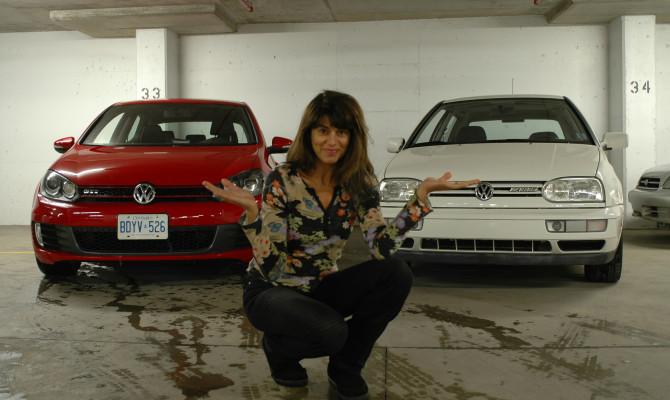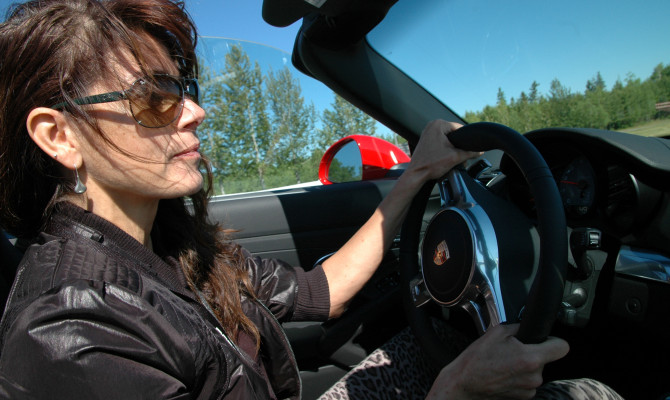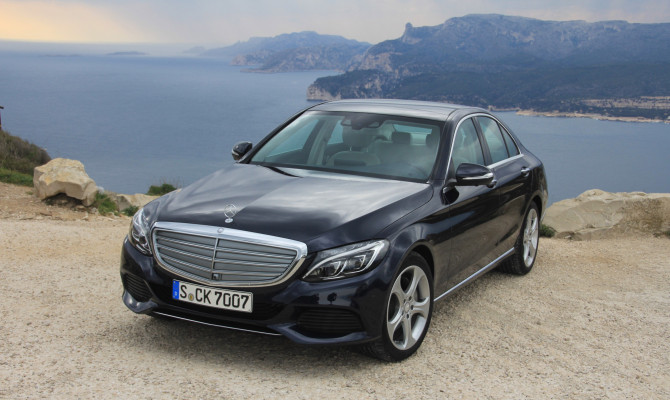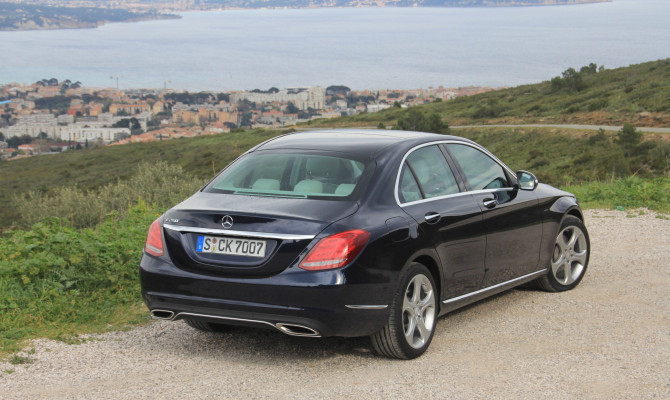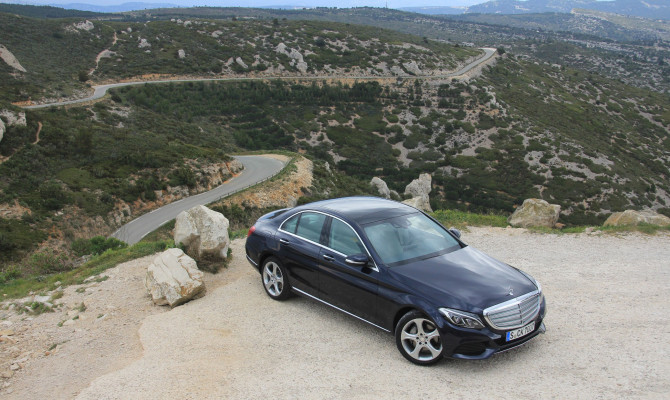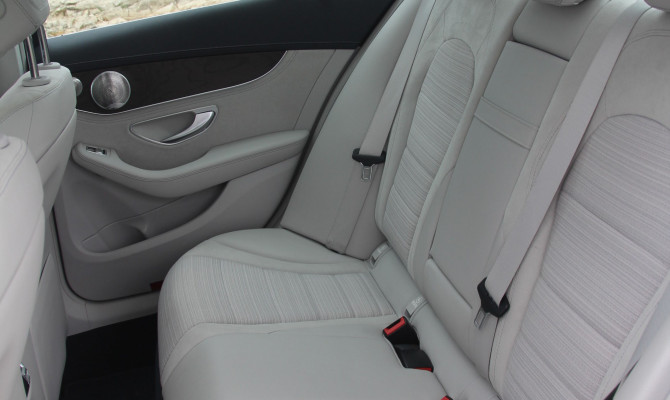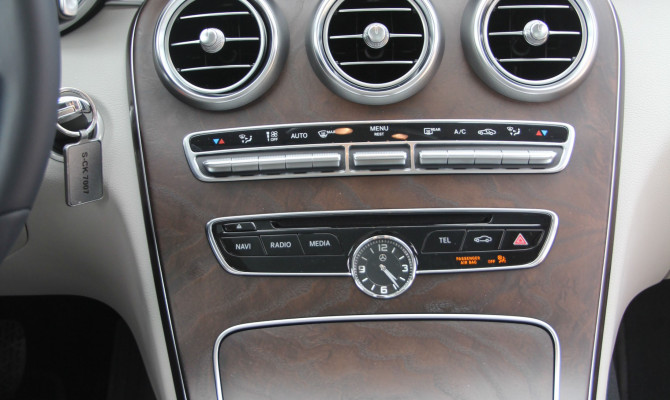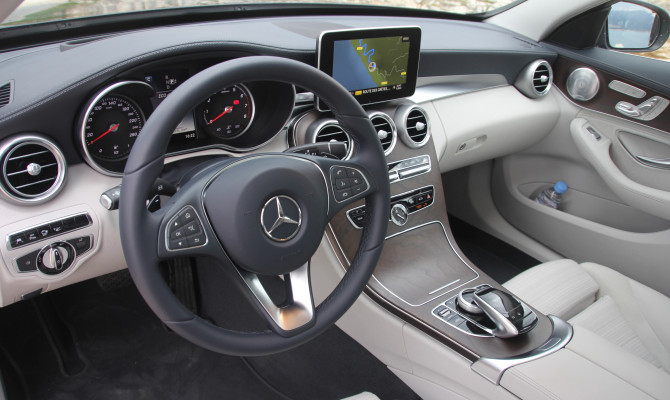“Music and road trips go together like American interstate highways and bad coffee.”
by Lisa Calvi
The first time I drove on public roads, I was at the wheel of my then-boyfriend’s Chevy Vega.
I remember cresting a hill and gasping sharply with the realization that I was in control. The curvy road splayed out far below wasn’t some carnival ride with someone else at the helm. I couldn’t just close my eyes and wait for the terror to subside. It was up to me.
I could coast down and weave gently through the corners or I could squeeze the throttle and feel the rush of acceleration and adrenaline. As a sixteen-year-old living in a small town, driving meant autonomy.
There were plenty of road trips growing up. I remember long hauls from Toronto to North Carolina and Florida with my dad driving. After he and my mom left Italy, they seemed to have an urge to see the new continent they now called home. Driving, I think, satisfied their curiosity about the world that they wanted to share with us.
When we moved back to Europe for a three-year period during my early teen years, the family would venture out each Sunday in our Peugeot 504 to discover a new region. Mom would be in the passenger seat with the maps and my baby brother asleep on her lap.
There was always music on those road trips. Music and road trips go together like American interstate highways and bad coffee. Music motivates, keeps you alert and adds to the euphoria of the open road.
Some of my fondest memories are of singing with my sister in the back seat of the Peugeot on the winding roads of Central France. Before iPads, iPhones, in-car entertainment systems and satellite radio, there were Beatles’ songs, ‘Michael, Row Your Boat Ashore’, and trying to remember all the words to ‘Bohemian Rhapsody’.
Road games involved spotting license plates from other countries, identifying makes of vehicles and fighting over whose turn it was to be a leaning post for sleeping baby brother, now in the back seat.
I’ve always been interested in cars, roads and travel. I love the growl of a revving eight-cylinder engine. A transport truck rolling down the highway at night all lit up just like a small city still gets me excited. I just never imagined that those things would be so engrained in my work and in my life. With our automotive event planning business, most days of the year, my husband Garry Sowerby and I are on the road.
It was this love of the road that brought us together. We could both relate to the words of Jack Kerouac in his classic ‘On the Road’:
“… We were leaving confusion and nonsense behind and performing our one noble function of the time, move.”
Our first date was a five-hour return drive to a ‘little spot’ my suitor knew. It must have worked. That was 17 years ago. Being ‘on the road’ is when our best scheming takes place. It’s romantic, soul-cleansing and gives us a sense of the wider world.
What about driving, though, actually gripping the wheel and pushing the throttle? Forget the destination, the freedom of movement, the road trip, the music. What is driving?
It’s that feeling that I got as I whipped a Porsche Boxster S around the tight-tight corners at a racetrack, squeezing through coned gates, powering down straight stretches and hearing the resonant instantly-recognizable growl of a Porsche engine. I had never driven faster, with such abandon yet with such intense concentration.
Or maybe I did. The 200 km/h reading on the digital speedometer of the Cadillac ATS I was driving on the back straightaway of one of the fastest, most challenging tracks in North America, Mosport, still flashes in my dreams.
None of this compares to driving my very own car, a pristine white 1999 Volkswagen Golf GTI VR6. When I bought it, I knew there were two extra cylinders under the hood than the Golf GL version and that it had an additional 57 horsepower. But when I drive it, I don’t think about horsepower, torque, or fuel economy.
Did somebody say ‘road trip’?
Follow Lisa on Twitter: @FrontLady
Superbly engineered, technically sophisticated and pleasure to drive…
Marseille, France.
The mid-sized C-Class is the most popular and affordable Mercedes-Benz sedan and about 8.5 million of them have been produced, since it was originally introduced in 1993.
Mercedes engineering typically operates on a seven-year “circle of life” production run and an all-new generation of C-Class will arrive in Canada, as a 2015 model year vehicle, this summer.
In brief, it’s a bigger and better C-Class, however, real progress is in the details. This C-Class is lighter, safer, comes with a choice of two more powerful (yet more fuel-efficient) new engines, uses even more advanced technologies, plus its body is more aerodynamic and, to my eyes, better looking. The South of France global launch location, even though I had to share it with over 800 other auto hacks, was another nice bonus – more later…
There’s no pricing available at this time, but we do know the initial trim levels offered in Canada will be a C300 and a C400. A sporty AMG edition, called the C63, will also be added to the line in January 2015. Although not official, a diesel edition is also expected to be added in 2015. At this event Mercedes was also showing a Euro-destined hybrid-diesel edition.
An optional (Airmatic) air suspension is offered for the first time in C-Class. It allows a driver to choose between Comfort, Eco, Sport, and Sport+ settings via an Agility Select switch on the console. The 4MATIC all-wheel drive system is, as before, the other major option. Also available is a Sport Package that includes AMG trim upgrades, wheels and front brake system.
The C-class has classic rear-drive vehicle proportions with a long hood (with a choice of two front grilles) and a short rear deck. It looks like a smaller version of the top-line, and redesigned last year, S-class, especially the new LED headlights and taillights. Compared to the current C-Class it’s longer, lower and wider and is now close in size to a 90s E-Class. Its extended wheelbase also helps create more interior space, especially for rear seat passengers.
The big change under-hood is a four-cylinder turbocharged 2.0-litre, in the C300, that’s max rated at 235 horsepower and 273 lb-ft of torque. While it produces more power than the outgoing base V6, I found the initial power surge, when you push on the gas pedal, overly aggressive. In fairness, the North American edition will come with different throttle mapping.
The twin-turbocharged 3.0-litre V6 in the C400, on the other hand, is a beauty. It can pump-out up to 329 horsepower and 354 lb-ft of torque. More importantly, it does so in a quieter, smoother and effortless fashion that most drivers expect when at the wheel of a Mercedes. Both engines come with idle fuel saving start/stop systems and are mated to a 7-speed automatic transmission.
The list of standard and available high-tech active safety features is simply amazing. It includes almost everything that’s available in the top-line S-Class, which is touted as the world’s safest car. Intelligent Drive is an optional suite of technologies that includes autonomous braking with pedestrian recognition, a low-speed heavy traffic auto-pilot feature, active parking assist and a 360-degree camera setup with numerous views of immediate surroundings.
Bordering on frivolous, there’s an Air-Balance in-car perfuming system … to prolong that new-car Mercedes smell. Another one is a GPS-linked climate-control system tech feature that automatically switches it to “recirculation” mode when a C-Class is driven into a tunnel.
The test drive actually did include a few tunnels and there are lots of them in and under Marseille. It’s the second largest city in France and its busiest port with numerous ferries to other Mediterranean destinations.
Our drive route took us out of the city on a circular mostly rural route around the outskirts of Marseille and ended at the picturesque small harbor community of Cassis. A mountain drive along the Route des Cretes (Route of the Ridges) was spectacular. It’s a narrow, winding high-elevation road with pull-offs at numerous view locations.
Even with the (100 kg) weight reduction, this C-Class is sublimely stable on the road. The switch to a full electronic assist rack and pinion steering system, called Direct Steer, is also flawless. There are fuel economy and active safety benefits.
Inside the seating is typical Mercedes with easy to find power controls on the door panel. Generous in size, yet excellent support and a good range of adjustable elements didn’t give my weak back a reason to complain, even after many hours of driving.
The restyled dash is an elegant and less fussy design, thanks mainly to a new Touchpad controller that eliminates a multitude of switches. It can recognise both single and multi-finger gestures, wiping movements, zoom finger gestures, even user handwriting.
That said, the stand-alone display screen looks out of place, as if an afterthought I-Pad was attached to the dash.
Overall, this C-Class is sure to please both purists and newcomers. Superbly engineered, technically sophisticated and pleasure to drive.
Recent Comments
- { Enjoyed your Forest of Bowland in the BMW X5M, particularly the photo of the BMW in front of the main part of Stonyhurst College where... }
- { Bantam designed the Jeep, not Willy's or Ford. The American military gave the original Bantam prototype to Willys and Ford to copy. There is plenty... }
- { All Escalades come with a 6.2-lilter V8 engine that produces 420 horsepower. A six-speed automatic is the only transmission offered and drives the rear wheels.... }
- { Alexandra is an excellent journalist. }
Popular Posts
- Journey to a ‘Sparkling’ Luxury Okanagan Resort “Four lucky readers will put a Dodge Journey’s weekend-...
- The Need For Speed: Hike Those Highway Limits More than half of those polled believe the province sho...
- Drives-U-Crazy… Erratic drivers. An early morning drive from Kelowna to Vancouver is nor...
- Readers Respond: The Pros and Cons of Increasing B.C. Speed Limits Increasing the speed limits will only increase risk to...
- Honda CR-V Review: The Compact Crossover To Get Things Done The CRV is a very stylish and aerodynamic crossover veh...


